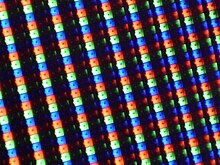Autostereoscopy

Autostereoscopy (from the Greek: auto = self - stereo = solid, rigid - skopein = see) describes a method for displaying three-dimensional images for an impression of depth through stereoscopic vision . With this technology, you don't need any aids directly in front of your eyes, such as head-mounted displays or 3D glasses . Typical methods for realizing autostereoscopic displays are mostly parallax barriers and lens grids , but volume displays and holography also belong in this definition.
Autostereoscopic 3D display
An autostereoscopic 3D display is understood to mean the display of autostereoscopic images on a screen or by means of a projection .
technology
In order to achieve a three-dimensional impression, two images are shown at the same time in autostereoscopic displays, whereby the light of individual pixels is deflected in different directions in front of the screen by means of parallax barriers , i.e. inclined strip masks or lens grids, and each eye reaches a different image. By dividing the screen area into two nested partial images, the horizontal resolution per eye is halved.
One problem with autostereoscopic displays, as with stereo images , is that the lens of the eye does not have to be focused on the perceived depth of a displayed object, but on the distance of the display, i.e. the deviation of the convergence and accommodation of the eye. Without training, this can lead to irritation and some people may experience eye and headaches when viewing such 3D images, especially over long periods of time.
Single view display
With a single view display, the depth effect is created by the fact that the screen shows "two" separate images. The user's head must be in a very restricted, optimal position ( sweet spot ) so that it gets a correct stereo impression. Some displays can compensate for limited lateral head movements by following the user with a video camera (so-called eye tracking or head tracking ) and changing the display in such a way that the "distribution" of the images to the eyes is correct again. Since the screen can only optimally respond to one pair of eyes, this autostereoscopic display is also called a single-user display . However, there is also a modification of this technique that calculates a compromise for the best view of all when there are several viewers. However, this average is then not as optimal as for a single person. Head and / or eye tracking is also not used on all single-view displays.
Multi-view display
With a multi-view display, more than 2 partial images are shown, so far 5–9 have been used, in some cases 24 and 64 have been tried, which increases the lateral freedom of movement, but the image quality (horizontal image resolution) decreases accordingly. They work similarly to wobble images , with these systems several users can see the 3D image. It is also possible to “look around” objects a little. This creates a hologram- like image impression. For objects that appear realistic, a volumetric 3D display is better suited (first patented in 1941 by the Scottish television pioneer John Logie Baird ).
history
The parallax barrier principle with inclined screens was patented in 1903 by the Englishman FE Ives as a "parallax stereogram". The lens grid technique was first proposed in 1908 by Gabriel M. Lippmann. Instead of using opaque parallax barriers, he put forward the idea of using a series of lenses.
An early application of the parallax barrier technology was the projection on "wire mesh screens", which was carried out for the first time in Moscow in 1930. Such a mechanical image separation system was postulated as early as 1906 by Estanawe , who proposed a fine grid of metal lamellas as a canvas. During the projection, the audience must be placed very precisely in front of the screen, otherwise the eyes cannot see the image that is intended for them. The system was improved by Noaillon , who inclined the grid to the viewer and moved the grid strips , which were now radially arranged, back and forth. The system was further developed by Ivanov , who instead of a mechanical parallel grid used 30,000 very fine copper wires as a canvas. The elaborate process was not ready for series production. Only one cinema was converted for the system, the Moskva in Moscow. Few films have been shown in this process.
Various autostereoscopic techniques have also been on the market for LCDs since around 2001 and have been mainly used in Jena (multi-view solution, 4D-Vision GmbH, today VisuMotion GmbH), Dresden (two-layer solution, Dresden 3D GmbH, today SeeReal Technologies), Berlin (two-layer solution, Heinrich-Hertz-Institut GmbH, today Fraunhofer HHI ) and Kiel (still image 30,000-view solution, RealEyes GmbH). Occasionally, laptops and TFT monitors with “Parallax Barrier” 3D displays (e.g. from Sanyo) have already been offered.
The technology of the Nintendo 3DS , for example, is based on the parallax barrier principle, while the Fujifilm Finepix Real 3D camera has an integrated lenticular display with a lenticular lens.
Web links
- German Society for Stereoscopy
- Autostereoscopic 3D monitors heise.de at CeBit 2000
- Video Fraunhofer HHI: Seeing in three dimensions without data glasses
Individual evidence
- ↑ 3D no better than 2D and gives filmgoers headaches, claims study . Retrieved June 8, 2012.
- ↑ David E. Roberts, History of Lenticular and related Autostereoscopic Methods , Leap Technologies, 2003, p. 3.
- ↑ E. Breetz: The systematic introduction of card reading in the lower level - an essential prerequisite for the effective organization of geography lessons. In: Wiss. Zt. D. PH Potsdam 14 (1970) 4, pp. 773-781. (Lenticular process).
- ^ Walter Funk: History of autostereoscopic cinema , hologlyphics.com


